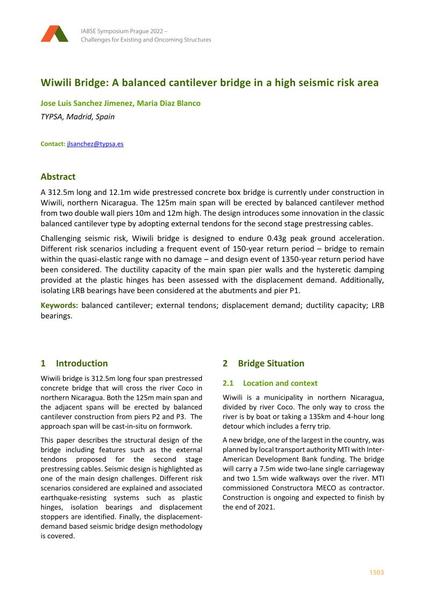Wiwili Bridge: A balanced cantilever bridge in a high seismic risk area

|
|
|||||||||||
Détails bibliographiques
| Auteur(s): |
José Luis Sánchez Jiménez
(TYPSA, Madrid, Spain)
Maria Diaz Blanco (TYPSA, Madrid, Spain) |
||||
|---|---|---|---|---|---|
| Médium: | papier de conférence | ||||
| Langue(s): | anglais | ||||
| Conférence: | IABSE Symposium: Challenges for Existing and Oncoming Structures, Prague, Czech Republic, 25-27 May 2022 | ||||
| Publié dans: | IABSE Symposium Prague 2022 | ||||
|
|||||
| Page(s): | 1503-1510 | ||||
| Nombre total de pages (du PDF): | 8 | ||||
| DOI: | 10.2749/prague.2022.1503 | ||||
| Abstrait: |
A 312.5m long and 12.1m wide prestressed concrete box bridge is currently under construction in Wiwili, northern Nicaragua. The 125m main span will be erected by balanced cantilever method from two double wall piers 10m and 12m high. The design introduces some innovation in the classic balanced cantilever type by adopting external tendons for the second stage prestressing cables. Challenging seismic risk, Wiwili bridge is designed to endure 0.43g peak ground acceleration. Different risk scenarios including a frequent event of 150-year return period – bridge to remain within the quasi-elastic range with no damage – and design event of 1350-year return period have been considered. The ductility capacity of the main span pier walls and the hysteretic damping provided at the plastic hinges has been assessed with the displacement demand. Additionally, isolating LRB bearings have been considered at the abutments and pier P1. |
||||
| Copyright: | © 2022 International Association for Bridge and Structural Engineering (IABSE) | ||||
| License: | Cette oeuvre ne peut être utilisée sans la permission de l'auteur ou détenteur des droits. |
||||
